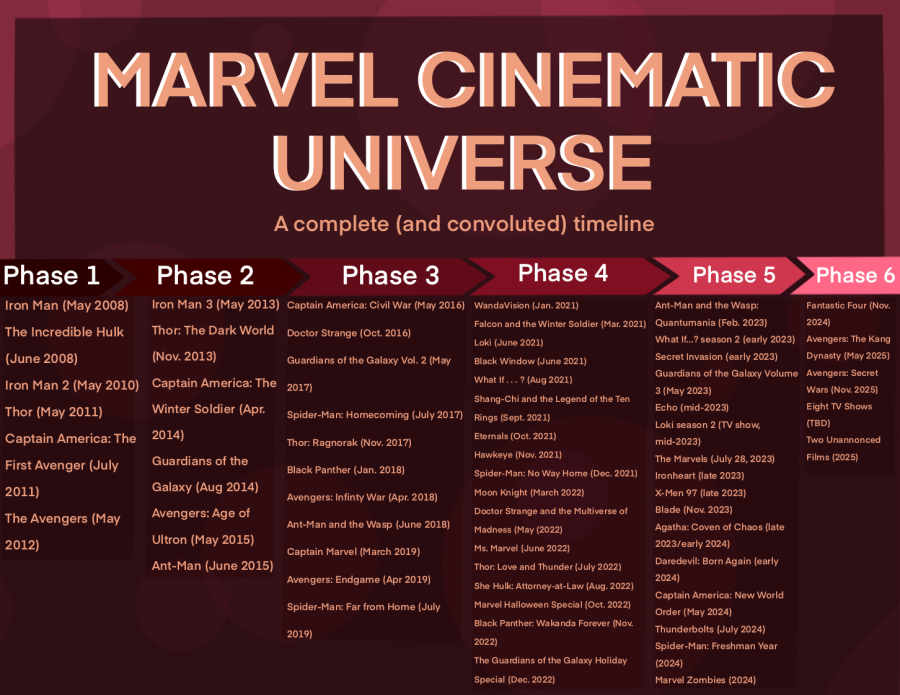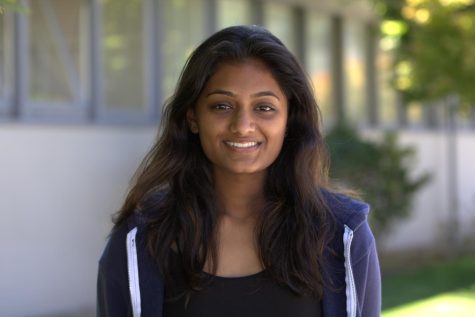Marvel: The past, present and future
PHASE 1
What started as a desperate attempt to revamp a bankrupt enterprise has developed into one of the most beloved cinematic universes of all time. Iron Man had it all. It captivated audiences with its charisma and extravagance, and generated a fanbase hooked on its relatability and depth — an element sorely lacking in previous superhero movies. In fact, it was this not-so-secret-ingredient that first allowed Marvel Comics to rise to success. We really should be thanking Stan Lee — the genius who thought up superheroes that thrived in normalcy— for bringing us such enthralling yet approachable characters.
The first phase was defined by the introduction of the six heroes who made up the original Avengers. However, in true Marvel fashion, this was not a linear experience. Four of the six characters received their own movies, giving Marvel both the chance to build up the cinematic universe, setting the scene for future crossovers, and to allow the audiences to develop emotional connections with each character.
Thus, when the six heroes eventually team up in the Phase One finale, ‘Avengers,’ it made perfect sense that they would spend the first part of the movie getting into petty arguments and not immediately functioning like a well-oiled machine. Of course, Tony Stark’s laid back, charismatic and eccentric personality would irritate the fu–flying Chitauri out of the disciplined and (some would argue) uptight Steve Rogers! They were humans after all, and if there is one thing that we humans are good at, it’s arguing. But that only made it more satisfying when the team finally came together in a climactic battle against Loki and the Chitauri, cementing the heroes as the original Avengers.
PHASE 2
As kids, we were repeatedly told that our actions have consequences, and who could better set that example than our favorite Avengers? Following ‘The Avengers,’ Phase Two focused on cleaning up the mess that resulted from that iconic battle between the Avengers and Loki.
Overall, Phase Two was successful. While the first phase was certainly unique, each film was still loosely confined to formulaic storylines. In the second phase, however, Marvel had the liberty to take more risks. And take risks they did. Rather than the single character introduction that the film previously stuck to, Marvel’s ‘Guardians of the Galaxy,’ gave us not only five new characters — a less formal version of the Avengers, if you will — but also a vastly more expansive universe.
And, of course, the genre remained humorous and action-packed. While we were introduced to their dynamic relationships in Phase One, Phase Two is where they connected. Inside jokes crossed screens and individual movies made references to other Marvel characters. This is the phase where the MCU evolves from a group of individual stories to a truly interconnected universe.
PHASE 3
Even people who have never watched a single Marvel movie have heard of Phase Three. After all, you would have had to be living under a rock for the past few years not knowing about ‘Infinity War’ or ‘Endgame.’ This phase is the culmination of every movie in the MCU. Right off the bat in ‘Captain America: Civil War,’ two fan favorites, Black Panther and Spiderman, are introduced along with an epic inter-Avenger battle that still manages to maintain that Marvel-esque humor in what would otherwise be a fairly serious situation. But the crowning glory of Marvel’s Phase Three is the ‘Infinity Wars’ and ‘Endgame’ saga.
The intergalactic hunt for the six stones captivated audiences long after they left theaters, and ‘Endgame’ became the highest grossing movie in history. However, with the close of the post-credit scene and key characters being written out of the plot, Marvel fans knew that Phase Four would be vastly different from the previous three.
PHASE 4
After leaving the theaters stunned from ‘Avengers: Endgame,’ it didn’t take long for fans to start speculating about what would come next. Following the second highest-grossing movie of all time may seem impossible, but Marvel’s favorite superheroes might be up to the task. Phase Four, the latest phase of the Marvel Cinematic Universe, may be the studio’s most ambitious and controversial phase yet.
‘Endgame’ was the epic culmination of 23 movies and 36 superheroes in one of, if not the best superhero fight scenes of all time. Upon its release, it became the highest-grossing movie and shattered box office records worldwide. So it may be an understatement to say that fans had high expectations for Marvel’s phase four productions.
From the moment phase four was announced, it was clear that there would be no equivalent of ‘Endgame.’ Instead, the new batch of Marvel movies and TV shows focused on revisiting individual superheroes and introducing new faces to the universe. While the extensive world-building created rich lore and compelling characters, the phase lacks a cohesive story. It’s hard to imagine the disconnected shows and movies coming together in an Endgame-esque finale. As the MCU expands, it also gets more difficult for new viewers to join the fanbase. The alternate plotlines being fleshed out in phase four are convoluted enough to confuse hardcore fans and can be daunting for newcomers.
While expanding the multiverse and exploring various theories of alternate timelines makes for very entertaining cinema, these developments also cheapen the stakes of the MCU. If a superhero’s death is never permanent because another version of them from an alternate timeline always exists, then it’s more difficult for the audience to develop strong emotional attachments to characters.
Marvel is also experimenting with various mediums of storytelling. With nine television shows airing exclusively on Disney+, it is clear the studio is leaning hard into its streaming services. While the initial TV shows such as ‘WandaVision’ and ‘Loki’ had massive followings and were widely enjoyed, the subsequent shows seem to be diminishing in popularity. The most recent, ‘She-Hulk’’ and ‘I am Groot,’ were much less viewed. Each show is still reaching millions of viewers, Marvel is in no significant danger, but it seems like the studio may be losing steam.
Phase Four has certainly left viewers with more questions than answers, setting the cinematic universe up for significant expansion. With a flurry of loose ends in Marvel’s recent pieces, it’s clear that Marvel has something unexpected up its sleeve — whether that be a renewed character, or a focused portrayal of a side character, will be revealed to us in the next phase.
PHASE 5
At last July’s San Diego Comic-Con, president of Marvel Studios Kevin Feige gave a rough outline of Phases Five and Six of the MCU. Phase Five will span early-2023 to mid-2024 and will include seven television series (all to be released on Disney+, of course) and seven films, while Phase Six will take up late 2024 and 2025. Phases Four, Five, and Six collectively make up the ‘Multiverse Saga.’
Phase Five’s movies will see hyped additions to popular series like ‘Guardians of the Galaxy,’ ‘Captain America’ and ‘Ant-Man’ as well as introductions to newer characters like Blade and Captain Marvel. In the television department, the popular thriller “Loki” and alternate-history animated series ‘What If…?’ will both be renewed in 2023, and ‘Daredevil’ will be rebooted on Disney+ rather than Netflix (which initially released the first three seasons of the show). In addition, multiple shows will center on lesser explored characters and storylines — often focusing on auxiliary characters from previous Marvel works like ‘WandaVision’ and ‘Hawkeye.’
At Comic-Con, Feige also previewed Phase Six. While we don’t know most of the details from this period, we learned that a Fantastic Four movie will kick off the phase in late 2024 and that the phase will conclude in 2025 with two Avengers ensemble films — ‘Avengers: The Kang Dynasty’ in May and ‘Avengers: Secret Wars’ in November. Little is known about the films except that Joseph and Anthony Russo, who produced the wildly-successful ensemble films ‘Avengers: Infinity War’ and ‘Avengers: Endgame,’ will not direct the films. Destin Daniel Cretton, who directed Marvel’s 2021 film ‘Shang-Chi and the Legend of the Ten Rings,’ will direct ‘The Kang Dynasty.’
WOMEN IN THE MCU
Recently, Marvel has debuted a variety of new female characters. However, for some, this representation and sudden focus on diversity seems forced and unrealistic. Some believe Marvel has only focused on these female characters due to the huge media outcry on feminism and political correctness. With the outpouring of (maybe) token diversity characters, like ‘Shang-Chi,’ ‘She-Hulk,’ ‘Ms. Marvel,’ etc. I ask you the question: does Marvel really care about the diversification of MCU or are they only doing it for media brownie points?
2008: ‘Iron Man’ introduces Pepper Potts, the first real female character we see introduced in the MCU, as Tony Stark’s main love interest. She adopts a stereotypical “sexy secretary” persona, with perfectly styled hair, formfitting suits and an enticing “hard to get” attitude. She is the epitome of a man’s picturesque woman: eye candy and competent.
2011: ‘Captain America: The First Avenger’ shows Peggy Carter as one of the heads behind SHIELD. Much like Pepper, her competence in the workforce takes a back seat to her looks. This movie continues the trend set by ‘Iron Man:’ women are objectifiable love interests first, and their own characters second.
2012: In ‘The Avengers,’ Black Widow is portrayed not as another one of Iron Man’s “sexy secretaries” (unfortunately for some) but as a spy in a skin-tight suit and curled hair that’s not very helpful for fighting. Along with her numerous provocative shots, Black Widow also uses a different form of fighting than the other heroes — wrapping her legs suggestively around the enemy’s head. Her whole shtick in ‘The Avengers’ is to use her femininity to make her enemies underestimate her and then completely annihilate them. But why does her competence and skill have to be centered around her looks?
2018: ‘Black Panther’ is released with an overwhelmingly positive response, scoring $1.347 billion worldwide and becoming the highest-grossing solo superhero film at its release. ‘Black Panther’ is one of the first MCU movies to actively have a strong female cast where most do not act as love interests to the hero. Okoye is the general of the Dora Milaje, leading the powerful Wakandan military, and princess Shuri is a headstrong teenage girl who is also canonically smarter than anyone in the MCU.
2022: ‘Ms. Marvel’ features a Pakistani-American teenage girl in a coming-of-age TV show. She is not sexualized nor defined by her femininity — the focus is heavily on her culture, not her gender. ‘Thor: Love and Thunder’ sees Jane Foster, Thor’s love interest and ex, as female Thor as well as Valkyrie the King of Asgard in Thor’s absence. ‘WandaVision’ is centered around the Scarlet Witch with Vision, a male character, taking on a supporting role: the opposite of basically every other Marvel TV show. ‘Black Widow’ reinvents Black Widow using actual practical suits and hairstyles, while adding an extra depth to her character that none of the other movies explored. Black Widow, instead of being a one-dimensional “sexy spy” with trauma, becomes a real character with a family, humor, and history.









